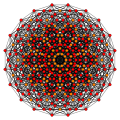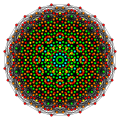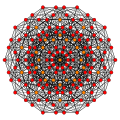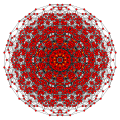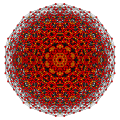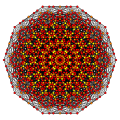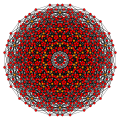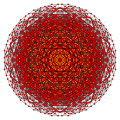Top Qs
Timeline
Chat
Perspective
Runcic 6-cubes
From Wikipedia, the free encyclopedia
Remove ads
In six-dimensional geometry, a runcic 6-cube is a convex uniform 6-polytope. There are 2 unique runcic for the 6-cube.
Runcic 6-cube
| Runcic 6-cube | |
|---|---|
| Type | uniform 6-polytope |
| Schläfli symbol | t0,2{3,33,1} h3{4,34} |
| Coxeter-Dynkin diagram | |
| 5-faces | |
| 4-faces | |
| Cells | |
| Faces | |
| Edges | 3840 |
| Vertices | 640 |
| Vertex figure | |
| Coxeter groups | D6, [33,1,1] |
| Properties | convex |
Alternate names
- Cantellated 6-demicube
- Cantellated demihexeract
- Small rhombated hemihexeract (Acronym: sirhax) (Jonathan Bowers)[1]
Cartesian coordinates
The Cartesian coordinates for the vertices of a runcic 6-cube centered at the origin are coordinate permutations:
- (±1,±1,±1,±3,±3,±3)
with an odd number of plus signs.
Images
Related polytopes
Remove ads
Runcicantic 6-cube
Alternate names
- Cantitruncated 6-demicube
- Cantitruncated demihexeract
- Great rhombated hemihexeract (Acronym: girhax) (Jonathan Bowers)[2]
Cartesian coordinates
The Cartesian coordinates for the vertices of a runcicantic 6-cube centered at the origin are coordinate permutations:
- (±1,±1,±3,±5,±5,±5)
with an odd number of plus signs.
Images
Remove ads
Related polytopes
This polytope is based on the 6-demicube, a part of a dimensional family of uniform polytopes called demihypercubes for being alternation of the hypercube family.
There are 47 uniform polytopes with D6 symmetry, 31 are shared by the B6 symmetry, and 16 are unique:
Notes
References
External links
Wikiwand - on
Seamless Wikipedia browsing. On steroids.
Remove ads












